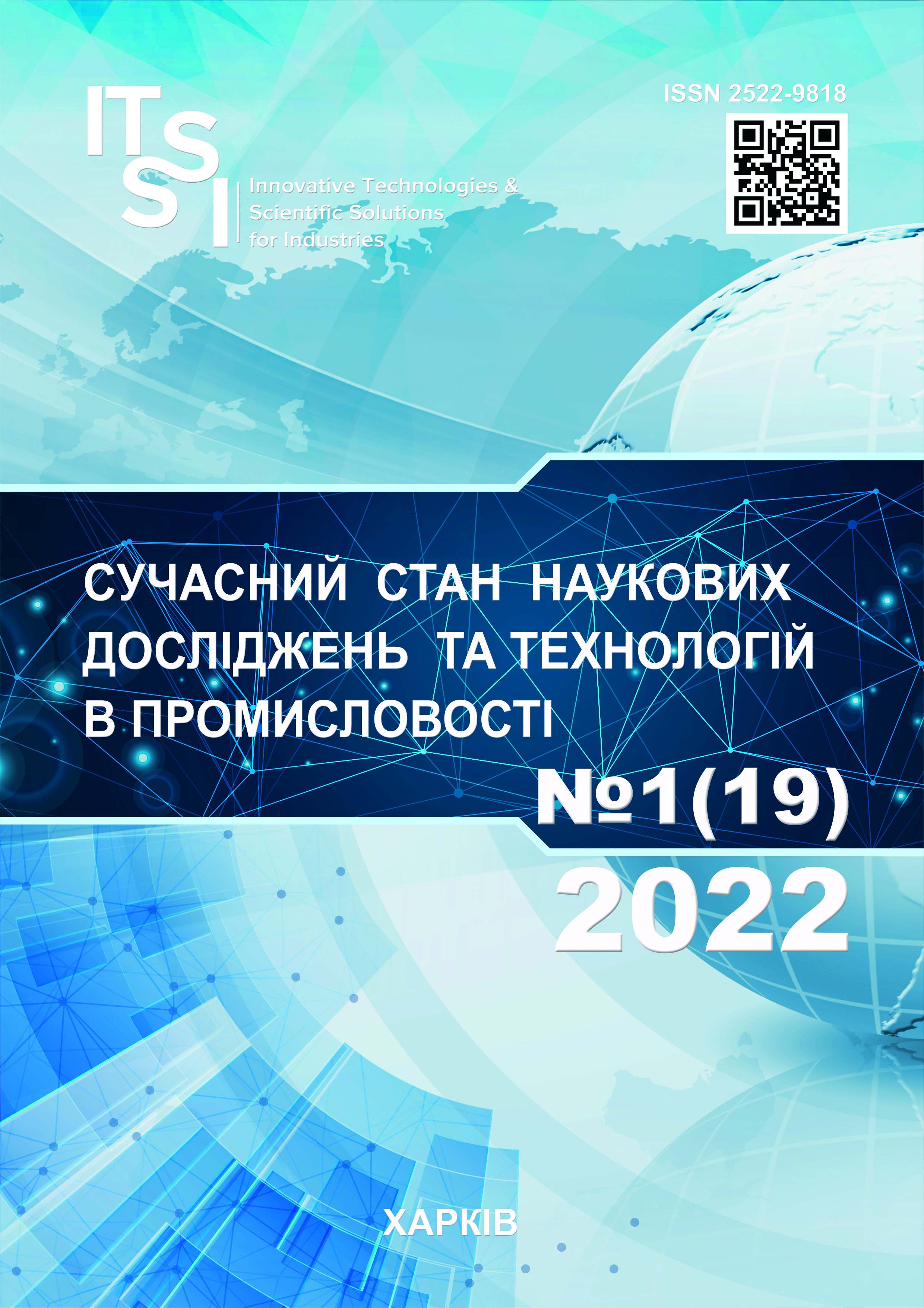ОЦІНКА ПРОГРАМНОЇ СКЛАДНОСТІ ОБЧИСЛЕННЯ КОЕФІЦІЄНТІВ АВТОРЕГРЕСІЇ ПРИ ЦИФРОВОМУ СПЕКТРАЛЬНОМУ АНАЛІЗІ
DOI:
https://doi.org/10.30837/ITSSI.2022.19.085Ключові слова:
спектральний аналіз;, авторегресія;, алгоритми Левінсона;, Дурбіна;, Тренча;, обчислювальна складність;, комп’ютерна арифметика;, мікроконтролериАнотація
Предметом дослідження у статті є алгоритми швидкого обчислення коефіцієнтів авторегресії при цифровому спектральному аналізі та оцінки кількості арифметичних операцій, необхідних для їх реалізації. Мета статті – порівняльний аналіз швидкодії різних алгоритмів обчислення коефіцієнтів авторегресії як складової частини алгоритмів спектрального аналізу, у тому числі аналіз складності їхньої мікроконтролерної реалізації. Завдання, що вирішуються: виділення методів спектрального аналізу, придатних для діагностики технологічного обладнання, аналіз методів обчислення коефіцієнтів авторегресії та виведення співвідношень для оцінювання програмної складності алгоритмів та розрахунок числових оцінок числа додавань та множень для деяких алгоритмів, адаптація розроблених методів та оцінок до мікроконтролерної реалізації аналізаторів спектру Застосовувані методи: теорія алгоритмів, перетворення Фур’є, натуральні ряди, програмування мікроконтролерів. Отримані результати: показано, що методи спектрального оцінювання на основі рівнянь Юла-Уолкера, що вимагають обчислення коефіцієнтів авторегресії, поєднує достатню роздільну здатність і стійкість до перешкод з прийнятною складністю реалізації. Отримано оцінки числа додавань та множень для алгоритмів Левінсона, Дурбіна та Тренча, виконано їх порівняльний аналіз. Розраховані часи обчислення для мікроконтролерної арифметики з фіксованою та плаваючою точкою. Висновки: При побудові аналізаторів спектра для діагностики технологічного обладнання доцільно застосовувати метод Юла-Уолкера. Порівняння алгоритмів Левінсона, Дурбіна та Тренча для обчислення коефіцієнтів авторегресії показало, що метод Тренча потребує мінімальної кількості додавань, а метод Дурбіна – мінімальної кількості множень. При мікроконтролерній реалізації аналізаторів спектра слід враховувати особливості використовуваної контролером арифметики. Метод Тренча є найбільш швидкодіючим у разі застосування арифметики з плаваючою точкою та невеликого порядку моделі. В інших випадках ефективніший метод Дурбіна.
Посилання
Shmelov, Y. M., Vladov, S. I., Kryshan, O. F., Gvozdik, S. D., Chyzhova, L. I. (2018), "Research of classification method of TV3-117 engine rating perations based on neural network technologies", ["Rozrobka metodu klasyfikatsii rezhymiv roboty aviatsiinoho dvyhuna TV3-117 na osnovi neiromerezhevykh tekhnolohii"], Innovative Technologies and Scientific Solutions for Industries, No. 4, P. 93–102. DOI: https://doi.org/10.30837/2522-9818.2018.6.093
Raskin, L., Sukhomlyn, L., Ivanchikhin, Y., Korsun R. (2021), "Method of identification of object states according to the results of fuzzy measurements of controlled parameters", ["Metod identyfikatsii staniv obiektu za rezultatamy nechitkykh vymiriuvan kontroliuvanykh parametriv"], Innovative Technologies and Scientific Solutions for Industries, No. 4 (18), P. 75–86. DOI: https://doi.org/10.30837/ITSSI.2021.18.075
Follum, J., Becejac, T., Etingov, P. A. (2021 ), "Robust Yule-Walker Method for Online Monitoring of Power System Electromechanical Modes of Oscillation", 2021 IEEE Power & Energy Society Innovative Smart Grid Technologies Conference (ISGT). DOI: https://doi.org/10.1109/ISGT49243.2021.9372152
TMForum (2021), "Application Framework (TAM)", available at: https://www.tmforum.org/application-framework (last accessed 15.12.2021).
TMForum (2021), "Information Framework (SID)", available at: https://www.tmforum.org/information-framework-sid. (last accessed 15.12.2021).
TMForum (2021), "Open Digital Architecture (ODA)", available at: https://www.tmforum.org/oda/ (last accessed 15.12.2021).
Goel, S. (2020), "The journey from CSP to DSP. Informa PLC", available at: https://telecoms.com/opinion/the-journey-from-csp-to-dsp/ (last accessed 15.12.2021).
Torosyan, E. K., Shekhovtsova, E. I., Akopyan, A. A. (2019), "Analysis of end-to-end methods for the basic architecture of telecom operator systems automation" ["Analiz metodov skvoznoy avtomatizatsii bazovoy arkhitektury sistem operatora svyazi"], Petersburg economic journal , No. 2., P. 172–177.
Newman, M. (2020), "FUTURE BSS. Say goodbye to software customization", available at: https://inform.tmforum.org/research-reports/future-bss-say-goodbye-to-software-customization/ (last accessed 15.12.2021).
TMForum (2020), "Cloud native OSS/BSS", available at: https://inform.tmforum.org/research-reports/cloud-native-oss-bss/ (last accessed 15.12.2021).
IIDA (2015), "A Guide to the Business Analysis Body of Knowledge (BABOK Guide)", IIBA, Р. 512.
Wiegers, K. I., Bitti, J. (2019), "Software Requirements (Developer Best Practices) 3rd Edition" ["Razrabotka trebovaniy k programmnomu obespecheniyu. 3-e izdanie, dopolnennoe"], BHV, Spb., Р. 736.
Mortensen, M. H., Offredo-Zreik, L. (2020), "Microservices-Based Cloud Native Modernization of OSS/BSS with Open Source. Informa PLC", available at: https://telecoms.com/intelligence/microservices-based- cloud-native-modernization-of-oss-bss-with-open-source/ (last accessed 15.12.2021).
McElligott, T. (2019), "Future OSS. Toward an Open Digital Architecture. TMForum", available at: https://inform.tmforum.org/research-reports/future-oss-towards-an-open-digital-architecture/ (last accessed 15.12.2021).
Smidovych, L.S., Kalmykov, A.V. (2010), "Perspective directions for the development of business processes automation technologies" ["Perspektivnye napravleniya razvitiya tekhnologiy avtomatizatsii biznes-protsessov"], Radioelectronic and Computer Systems, Vol. 4 (45), P. 75–81.
Turkington, I. (2021), "Open Digital Framework, Open Digital Architecture. ITU-T". Virtual forum on The Role of Standards in Accelerating Digital Transformation for Cities and Communities, Р. 42.
Andersen, L (2021), "Designing lasting simplification into a BSS contract. TMForum", available at: https://inform.tmforum.org/digital-transformation-and-maturity/2021/08/designing-lasting-simplification-into-a-bss-contract/ (last accessed 15.12.2021).
Newman, M. (2021), "Next generation BSS: the Telefónica way. TM Forum", available from: https://inform.tmforum.org/research-reports/next-generation-bss-operator-and-vendor-perspectives (last accessed 15.12.2021).
Fedorovich, O.Ye., Babich, A.V. (2016), "Optimization of multilevel component architecture software system" [“Optimizatsiya mnogourovnevoy komponentnoy arkhitektury programmnoy sistemy”], Information Processing Systems, 2016. Vol. 1 (75), Р. 175–177.
##submission.downloads##
Опубліковано
Як цитувати
Номер
Розділ
Ліцензія

Ця робота ліцензується відповідно до Creative Commons Attribution-NonCommercial-ShareAlike 4.0 International License.
Наше видання використовує положення про авторські права Creative Commons для журналів відкритого доступу.
Автори, які публікуються у цьому журналі, погоджуються з наступними умовами:
Автори залишають за собою право на авторство своєї роботи та передають журналу право першої публікації цієї роботи на умовах ліцензії Creative Commons Attribution-NonCommercial-ShareAlike 4.0 International License (CC BY-NC-SA 4.0), котра дозволяє іншим особам вільно розповсюджувати опубліковану роботу з обов'язковим посиланням на авторів оригінальної роботи та першу публікацію роботи у цьому журналі.
Автори мають право укладати самостійні додаткові угоди щодо не комерційного та не ексклюзивного розповсюдження роботи у тому вигляді, в якому вона була опублікована цим журналом (наприклад, розміщувати роботу в електронному сховищі установи або публікувати у складі монографії), за умови збереження посилання на першу публікацію роботи у цьому журналі.
Політика журналу дозволяє і заохочує розміщення авторами в мережі Інтернет (наприклад, у сховищах установ або на особистих веб-сайтах) рукопису опублікованої роботи, оскільки це сприяє виникненню продуктивної наукової дискусії та позитивно позначається на оперативності та динаміці цитування опублікованої роботи.














